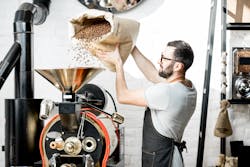About ten years after Starbucks redefined the coffee business, the “Third Wave” of coffee came on the scene with an emphasis on craftsmanship, single origin beans and some very slick marketing. Many of the Third Wave micro roasters gained a loyal legion of followers. Now comes the “Fourth Wave” – with an emphasis on local roasting and a new generation of clients who want these artisan coffees for their employees.
Unlike the “Third Wave” of coffee, which required operators to source a couple of big names among trendsetting roasters, like Stumptown or Café Intelligentsia, the “Fourth Wave” is all about local roasters and their stories. In some larger metropolitan markets, the request list for coffee from local roasters is increasing rapidly, creating a new challenge for coffee service operators.
Locally roasted – a new priority
Joe Simonovich, chief growth officer at Corporate Essentials, located in the greater New York area, said his company is getting a steady flow of requests for locally roasted coffee from all types of clients. “It’s not just tech and entertainment,” said Simonovich. “As a result, we are currently working with 15 to 18 local roasters in our area.”
West Coast operators are experiencing the same trend. Cory Enos, director of customer success at BlueStar Refreshment Services, based in the San Francisco Bay area, said the company's clients are quite sophisticated about coffee. “What we are noticing is a rebellion against some of the Third Wave coffees because they have become too big and are seen as too corporate. Now, our clients want to support the local companies instead," Enos said.
According to Seattle-based Arthur Siller, vice president of operations & business development at Avanti Markets Northwest, his clients want local roasters more than ever before. “The clients want something more than just coffee as a beverage. They want the story behind the roaster. They want to participate in the decision to use a specific roaster,” said Siller, who believes the trend is driven primarily by millennials.
“Clients are interested in sustainability practices, both ethical and environmental, and are interested in the answers to certain questions. How do they treat their employees and the farmers? Is the roaster minimizing their footprint as much as possible? Is the roaster supporting any causes? Most important of all – is the roaster a local business, a part of the local community?” he added.
While large metro area operators on both coasts are receiving multiple requests for local artisan roasters, some areas of the country are adopting the trend more slowly. Rob Jessup, regional manager at Standard Coffee Service Company, said that in the southeastern region, the trend toward local roasters is less prevalent. “There is greater interest in the larger regional micro roasters than the small local roasters,” said Jessup. “We know the move toward local is coming, but so far, we aren’t overwhelmed with requests.”
Some sound advice
Robert Donohue, customer service manager at Canteen of Sacramento, said he focuses on communication when dealing with clients who are impatiently demanding locally roasted coffee. “Be honest and communicate with the clients – let them know that bringing on a new local coffee is a process, not just the flip of a switch,” said Donohue.
Rodney Turner, vice president at Coffee Distributing Corp, in the greater New York City area, said the trend toward locally roasted coffees will only increase, so operators need to accept the following if they want to successfully navigate this “Fourth Wave” of coffee:
1. Change is good.
2. We will be increasing our offerings.
3. We need to develop strong relationships with the local roasters.
A different approach
Steve Brehm, president of Minnesota-based Berry Coffee Company, made a dramatic move at his company to accommodate the demand for locally roasted coffee. “We have a roasting plant and for three years now, we have been roasting our own coffee,” said Brehm, an operator for 40 years.
What does Brehm do when a client asks for a coffee from a local competitor? Brehm and his team will analyze and reconstruct the profile of that coffee – bean type, taste and roast color – duplicating the coffee as much as possible and bringing in the client for a private tasting session in the roasting plant. “This approach usually satisfies the client and it’s fun for everyone, but if a big customer insists on something we do not carry and we need to supply it, we will,” said Brehm.
A Positive Trend
Overall, operators see the trend toward locally roasted coffees as a positive.
“We are helping our clients give their employees a workplace environment that matches their culture,” said Donohue.
“When you provide locally roasted coffee for clients, there is less price resistance, great relationship building and higher account retention,” added Simonovich.
“We expect the requests to increase and we will continue to promote it,” said Siller. “Providing locally roasted artisan coffee is another way to separate us from our competition. The last thing I want to hear is that we lost a client because we didn’t have a specific coffee in our product line.”
About the Author

Bob Tullio
Bob Tullio is a content specialist, speaker, sales trainer, consultant and contributing editor of Automatic Merchandiser and VendingMarketWatch.com. He advises entrepreneurs on how to build a successful business from the ground up. He specializes in helping suppliers connect with operators in the convenience services industry — coffee service, vending, micro markets and pantry service specifically. He can be reached at 818-261-1758 and [email protected]. Tullio welcomes your feedback.
Subscribe to Automatic Merchandiser’s new podcast, Vending & OCS Nation, which Tullio hosts. Each episode is designed to make your business more profitable.
